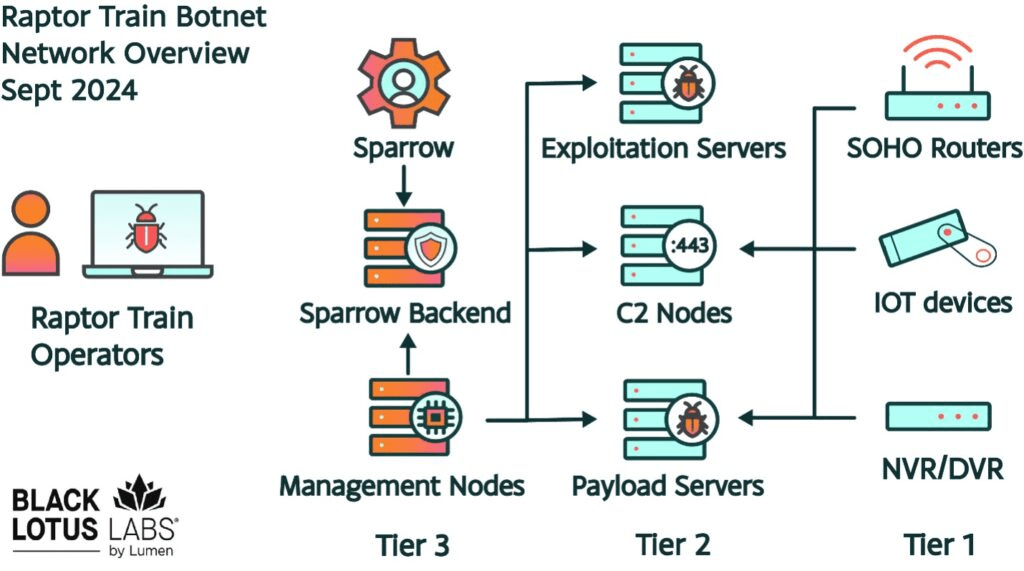
2024-9-19 03:50:14 Author: securityaffairs.com(查看原文) 阅读量:25 收藏
Experts warn of China-linked APT’s Raptor Train IoT Botnet
Pierluigi Paganini
September 18, 2024

Researchers warn of a new IoT botnet called Raptor Train that already compromised over 200,000 devices worldwide.
Cybersecurity researchers from Lumen’s Black Lotus Labs discovered a new botnet, named Raptor Train, composed of small office/home office (SOHO) and IoT devices. The experts believe the botnet is controlled by a Chine-linked APT group Flax Typhoon (also called Ethereal Panda or RedJuliett).
The botnet has been active since at least May 2020, reaching its peak with 60,000 compromised devices in June 2023.
Since May 2020, over 200,000 devices, including SOHO routers, NVR/DVR devices, NAS servers, and IP cameras, have been compromised and added to the Raptor Train botnet, making it one of the largest China-linked IoT botnets discovered. A command and control (C2) domain from a recent campaign even appeared on the Cloudflare Radar and Cisco Umbrella “top 1 million” lists, indicating widespread device exploitation. Researchers estimate that hundreds of thousands of devices have likely been compromised since the botnet’s creation.
“The botnet operators manage this large and varied network through a series of distributed payload and C2 servers, a centralized Node.js backend, and a cross-platform Electron application front-end that the actors have dubbed “Sparrow.” This is a robust, enterprise-grade control system used to manage upwards of 60 C2 servers and their infected nodes at any given time.” reads the report published by Lumen. “This service enables an entire suite of activities, including scalable exploitation of bots, vulnerability and exploit management, remote management of C2 infrastructure, file uploads and downloads, remote command execution, and the ability to tailor IoT-based distributed denial of service (DDoS) attacks at-scale.”
The three-tiered architecture consists of the following levels:
- Tier 1: Compromised SOHO/IoT devices
- Tier 2: Exploitation servers, payload servers, and command-and-control (C2) servers
- Tier 3: Centralized management nodes and a cross-platform Electron application front-end referred to as Sparrow (aka Node Comprehensive Control Tool, or NCCT)
The Raptor Train botnet operates as a multi-tiered, evolving network with at least three levels of activity observed over four years. Tier 3 “Sparrow” nodes initiate bot tasks, which are routed through Tier 2 command and control (C2) servers to Tier 1 bots. Tier 1, the largest level, is composed of compromised devices with a short lifecycle, averaging 17 days. Tiers 2 and 3 use Virtual Private Servers (VPSs), lasting around 77 days, with Tier 3 primarily based in Hong Kong and China. Tier 2 servers are distributed globally, managing the control and exploitation capabilities of the bot.

Below are some of the devices included in the botnet:
Modems/Routers
- ActionTec PK5000
- ASUS RT-*/GT-*/ZenWifi
- TP-LINK
- DrayTek Vigor
- Tenda Wireless
- Ruijie
- Zyxel USG*
- Ruckus Wireless
- VNPT iGate
- Mikrotik
- TOTOLINK
IP Cameras
- D-LINK DCS-*
- Hikvision
- Mobotix
- NUUO
- AXIS
- Panasonic
NVR/DVR
- Shenzhen TVT NVRs/DVRs
NAS
- QNAP (TS Series)
- Fujitsu
- Synology
The attribution of the Raptor Train botnet to the Chinese nation-state actor is based on multiple factors, including the operational timelines, targeting of sectors aligned with Chinese interests, use of the Chinese language, and other tactics, techniques, and procedures (TTPs) that overlap with known Chinese cyber activities.
“This botnet has targeted entities in the U.S. and Taiwan across various sectors, including military, government, higher education, telecommunications, defense industrial base, and IT.” concludes the report. “The investigation has yielded insights into the botnet’s network architecture, exploitation campaigns, malware components, and operational use, illuminating the evolving tactics and techniques employed by the threat actors. A major concern of the Raptor Train botnet is the DDoS capability that we have not yet observed actively deployed, but we suspect is being maintained for future use. “
Follow me on Twitter: @securityaffairs and Facebook and Mastodon
(SecurityAffairs – hacking, botnet)
如有侵权请联系:admin#unsafe.sh